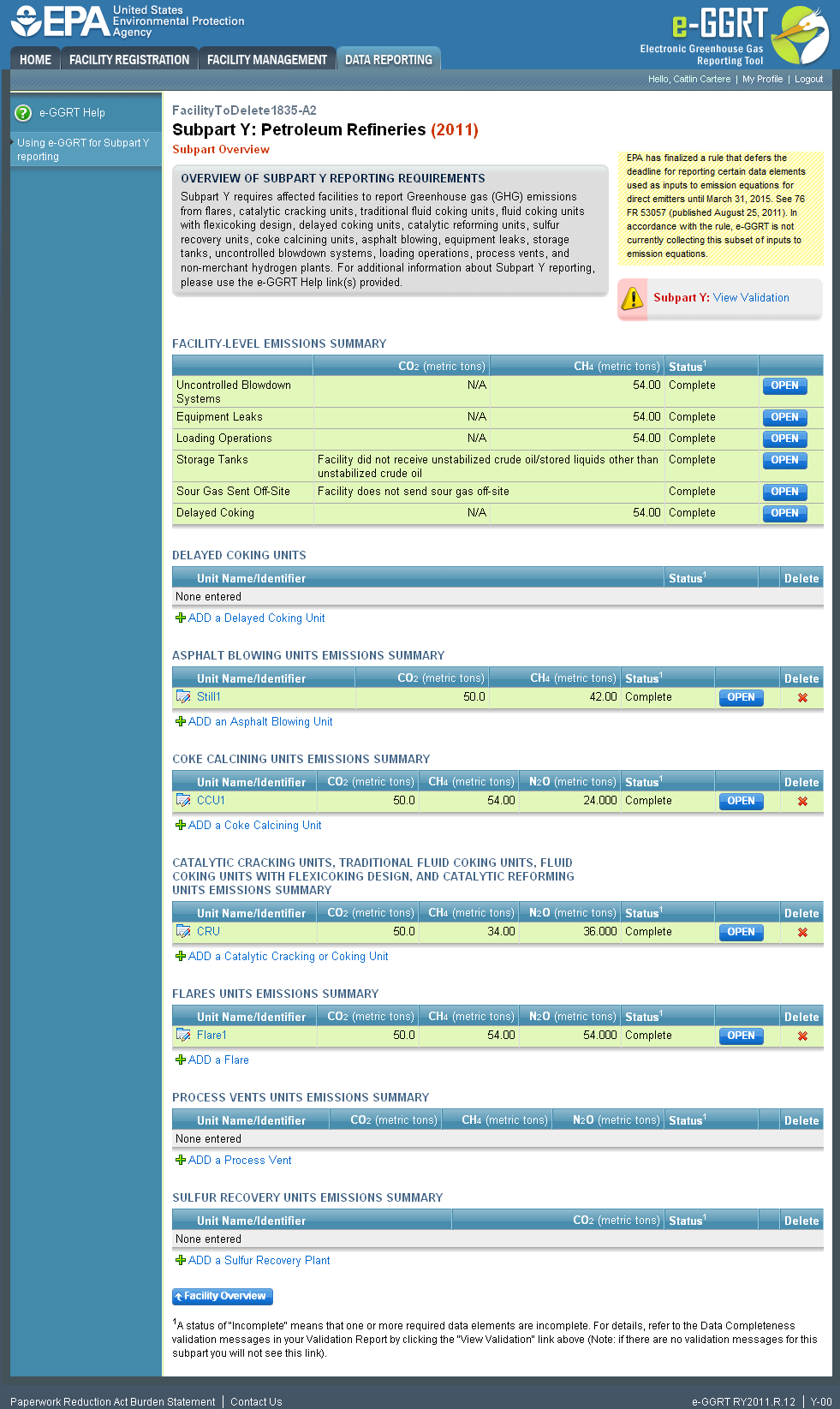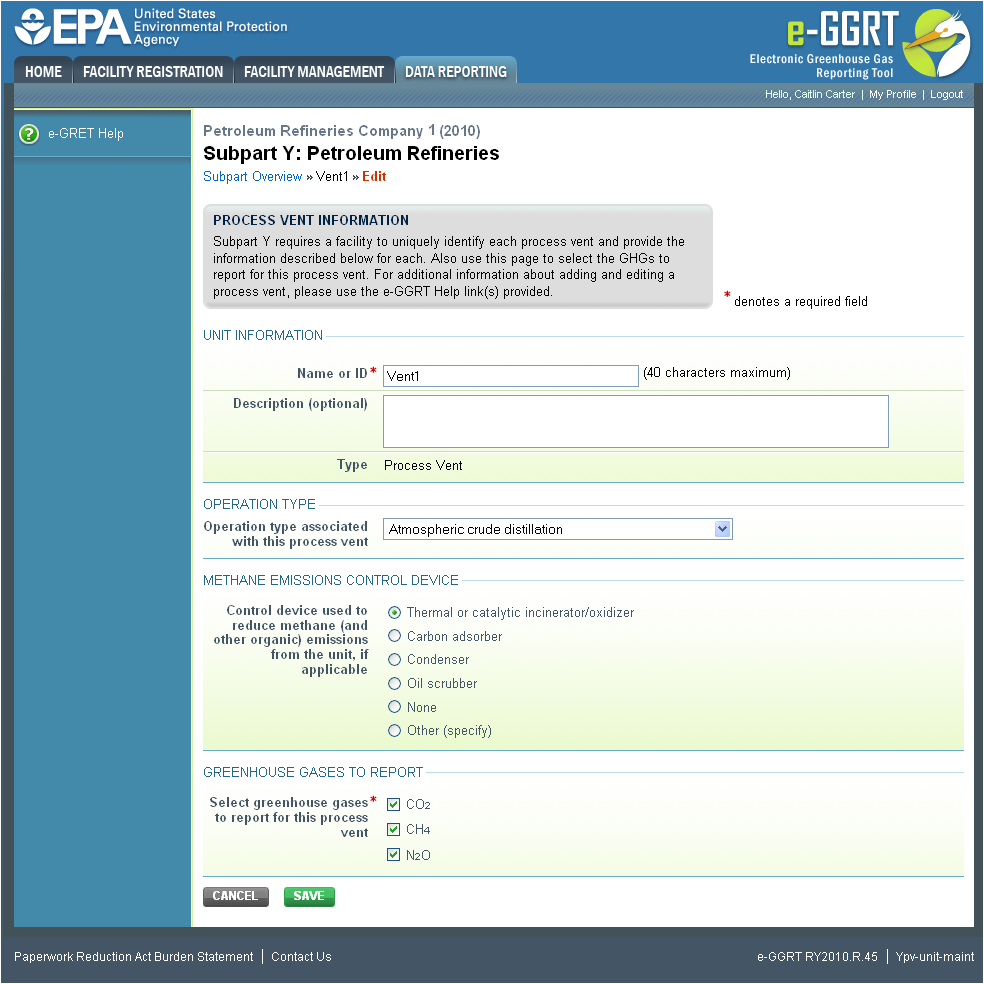This topic provides a step-by-step description of how to enter Subpart Y Process Vents unit information about this facility.
Adding or Updating Process Vents Unit Information
Click this link to expand
To add or update Subpart Y Process Vents unit information for this Facility, locate the PROCESS VENTS UNITS EMISSIONS SUMMARY table on the Subpart Y Overview page.
Click the link titled "ADD a Process Vent."
To edit an existing Process Vent unit, click on the edit icon or the Name/ID link, which is the first column in the PROCESS VENTS UNITS EMISSIONS SUMMARY table.
To delete an existing Process Vent unit, click on the delete icon, which is the last column in the PROCESS VENTS UNITS EMISSIONS SUMMARY table.
Click this link to expand
Subpart Y collects the following data about your Process Vent unit:
- A unique name or identifier, plus optional description for this process vent unit (see also About Unique Unit Names):
- Operation type associated with this process vent:
- Atmospheric crude distillation
- Vacuum distillation
- Delayed coking
- Fluid coking (traditional)
- Flexicoking
- Visbreaking, other thermal cracking
- Fluid catalytic cracking unit
- Non-fluid catalytic cracking unit
- Catalytic hydrocracking
- Catalytic reforming unit – continuous regeneration
- Catalytic reforming unit – cyclic regeneration
- Catalytic reforming unit – semi-regenerative
- Fuels solvent deasphalting
- Desulfurization/ hydrotreat – naphtha/reformer feed
- Desulfurization/ hydrotreat – gasoline
- Desulfurization/ hydrotreat – kerosene/jet fuel
- Desulfurization/ hydrotreat – diesel
- Desulfurization/ hydrotreat – other distillate
- Desulfurization/ hydrotreat – residual
- Desulfurization/ hydrotreat – heavy gas oil
- Desulfurization/ hydrotreat --other
- HF alkylation
- H2SO4 alkylation
- Aromatics production
- Asphalt production
- Isomerization – Isobutane
- Isomerization – Iso C5,C6
- Lubricants production
- Petroleum coke storage
- Sulfur plant
- Gas plant (LPG production unit)
- Oxygenate plant – MTBE
- Oxygenate plant – ETBE
- Oxygenate plant – TAME
- Oxygenate plant – other (specify)
- Marine vessel loading/unloading
- Truck/tank truck loading/unloading
- Rail car loading/unloading
- Blow down system
- Knock-out pot
- Analyzer
- Vacuum jet exhaust
- Wastewater treatment unit
- Wastewater collection system (drain, junction box, etc.)
- Soil remediation
- Other
- Control device used to reduce methane (and other organic) emissions from the unit:
- Thermal or catalytic incinerator/oxidizer
- Carbon adsorber
- Condenser
- Oil scrubber
- None
- Other (specify)
Greenhouse gases to report for this process vent. Select any combination of CO2, CH4 or N2O. CO2 emissions must be reported if the process vent contains greater than 2 percent by volume CO2 or greater. CH4 emissions must be reported if the process vent contains 0.5 percent by volume of CH4 or greater. N2O emissions must be reported if the process vent contains 0.01 percent by volume of N2O or greater. You must use Equation Y-19 for catalytic reforming unit depressurization and purge vents when methane is used as the purge gas.
When you are finished, click SAVE.
Adding or Updating Process Vents Unit Emissions Information
This page provides a step-by-step description of how to enter Subpart Y Process Vents unit GHG and associated data.
To add or update Subpart Y Process Vents unit emissions information, locate the PROCESS VENTS UNITS EMISSIONS SUMMARY table on the Subpart Y Overview page, and click OPEN.
Click this link to expand
Subpart Y collects the following data about your Process Vent unit:
- Annual volumetric flow discharged to the atmosphere (scf)
- Method used to measure or estimate the annual volumetric flow rate:
- Continuous or at least hourly measurements
- Routine (less frequent than hourly but at least weekly) measurements
- Periodic (less frequent than weekly) measurements
- Process knowledge
- Engineering calculation
- Other (specify)
- Number of venting events, if vent is intermittent (see note below)
- Cumulative venting time (hours)
Note that number of venting events is not applicable for continuous venting in which case you may leave this field blank
Subpart Y collects the following data if CO2 is being reported for this Process Vent:
- Annual CO2 emissions from this process vent (metric tons). To calculate this value download the spreadsheet by clicking the link titled “Use Y-19 spreadsheet to calculate.” Fill in the spreadsheet using the instructions in the spreadsheet. After completing the spreadsheet, copy the value of CO2 calculated by the spreadsheet to this page in the box next to “Annual CO2 emission from this process vent (metric tons).”
- Annual average mole fraction of CO2
- Method used to measure or estimate the annual average mole fraction of CO2:
- Engineering estimates/process knowledge
- Direct measurement
- Other (specify)
Subpart Y collects the following data if CH4 is being reported for this Process Vent:
- Annual CH4 emissions from this process vent (metric tons). To calculate this value download the spreadsheet by clicking the link titled “Use Y-19 spreadsheet to calculate.” Fill in the spreadsheet using the instructions in the spreadsheet. After completing the spreadsheet, copy the value of CH4 calculated by the spreadsheet to this page in the box next to “Annual CH4 emission from this process vent (metric tons).”
- Annual average mole fraction of CH4
- Method used to measure or estimate the annual average mole fraction of CH4:
- Engineering estimates/process knowledge
- Direct measurement
- Other (specify)
Subpart Y collects the following data if N2O is being reported for this Process Vent:
- Annual N2O emissions from this process vent (metric tons). To calculate this value download the spreadsheet by clicking the link titled “Use Y-19 spreadsheet to calculate.” Fill in the spreadsheet using the instructions in the spreadsheet. After completing the spreadsheet, copy the value of N2O calculated by the spreadsheet to this page in the box next to “Annual N2O emission from this process vent (metric tons).”
- Annual average mole fraction of N2O
- Method used to measure or estimate the annual average mole fraction of N2O:
- Engineering estimates/process knowledge
- Direct measurement
- Other (specify)
The Equation Y-19 Summary is presented on the page. You can hover over an element in the equation to reveal a definition of that element.
When you have finished entering emission results, click SAVE.
See Also
Screen Code
Using e-GGRT to Prepare Your Subpart Y Report
- Subpart Y Summary Information for this Facility
- Subpart Y Asphalt Blowing Unit Information for RY2018 and Later Years
- Subpart Y Delayed Coking Unit Information
- Subpart Y Asphalt Blowing Unit Information
- Subpart Y Asphalt Blowing Unit Information for RY2014 - RY2017
- Subpart Y Coke Calcining Unit Information
- Subpart Y Catalytic Cracking, Fluid Coking, and Catalytic Reforming Unit Information
- Subpart Y Delayed Coking Unit Information for RY2018 and Later Years
- Subpart Y Delayed Coking Unit Information for RY2014 - RY2017
- Subpart Y Flares Unit Information
- Subpart Y On-Site Sulfur Recovery Plant Information
- Subpart Y Process Vents Unit Information
- Subpart Y Emissions Information for Process Units Monitored by CEMS
- Subpart Y Entering Equation Inputs Using IVT
- Subpart Y IVT Equation Inputs Summary
- Using Subpart Y Calculation Spreadsheets




